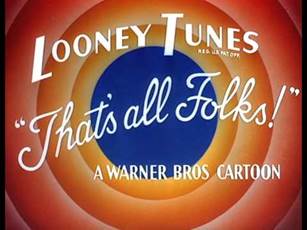Seventy-five years ago (1946)…
Looney Tunes released “Baseball Bugs” (as in Bugs Bunny).
Bob Hope became a part owner of the Cleveland Indians (to be known as the Guardians starting in 2022).
I was five years old. Let’s see, 75 + 5 = 80. Next Monday, August 9, is the big birthday date, and Rita is taking me to the Royals/Yankees game to celebrate. She scored David Block’s front row seats, so you might see us behind the third-base dugout when the TV camera focuses on the right hand batters. That day is also the 50th anniversary of Satchel Paige’s induction into the Hall of Fame. The Royals will have on hand Satchel’s Hall of Fame plaque. Expect a report in the next Hot Stove.
Speaking of the Royals…
Royals Update: The Royals roller coaster season continues.
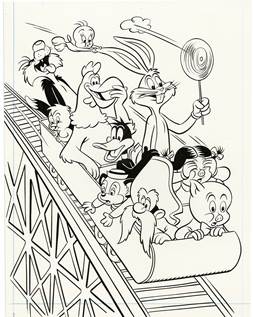
1. Opening Day (April 1) to May 2. Best record in baseball. 16-10
2. May 3 to the All-Star game (July 13). Not the best. 20-43
3. All-Star game to July 29. Best record in baseball. 9-3
4. July 30 to last night. Ouch. 0-4
Cumulative for the season: 45-60
To view this in a moving graph, click here.
Royals Photos/Videos: The Royals photo/video team consistently posts eye-catching images. Here are some recent examples.
Jason Hannah. Love the sunset on the fountains.

Hayley Mertens: Last Friday night, the Royals were in Toronto for the first Blue Jays home game at Rogers Centre since 2019. Covid travel restrictions by Canada had limited their “home” games to Dunedin (FL) and Buffalo (NY). The Royals gave them a touching welcome home in a short video produced by Hayley Mertens (click here).
Sam Lutz: I did not know what to expect when I saw this tweet from Sam Lutz. “Gimbal home run last night with Salvador Perez.” It turned out to be a cool video of the fan reaction to a homer by Salvy (click here).
But what’s a gimbal? I looked it up. It’s a “pivoted support that permits rotation of an object on an axis.” Put three of them together in a 3-axis arrangement and you can, for example, keep the compass level on a ship that is pitching and rolling on the sea. Or act as a stabilization system to give a camera operator the independence of handheld shooting without camera vibration or shake. Over my head, but it certainly works nicely for Sam.
[Gimbal Trivia: When I was a kid, I had a gimbal-based toy, but did not know the term. It was a gyroscope that looked like the one below and operated as shown in this video.]

Looney Tunes – Baseball Bugs at 75: In 1946, Looney Tunes released Baseball Bugs, described by one pundit as “so packed with funny gags, clever puns, imaginative imagery and lively music that it’s still recognized as one of the best.” The setting is the Polo Grounds in New York, and Bugs Bunny plays for the home team, the Teetotalers. The visiting team, the Gas-House Gorillas, take a 96-0 lead, rounding the bases so often that they form a Conga line (click here). Bugs leads his team back as a two-way star. His superhuman pitching and hitting remind me of Bullet Rogan and Shohei Ohtani.
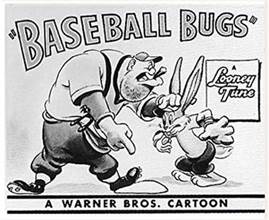
It’s a fun seven minutes (click here for the full cartoon). [Hidden gem: Bugs uses a President Biden nostalgic term while arguing with the umpire, “Where do you get that malarkey? I’m safe!.”]
Looney Tunes – Chuck Jones: One of the legends of animation is Chuck Jones. He wrote, produced and directed hundreds of classic cartoons, mostly with Warner Brothers (Looney Tunes and Merrie Melodies). He also created many works of art featuring the cartoon characters. In this fun piece, he imagines a pick-up game at a neighborhood sandlot.
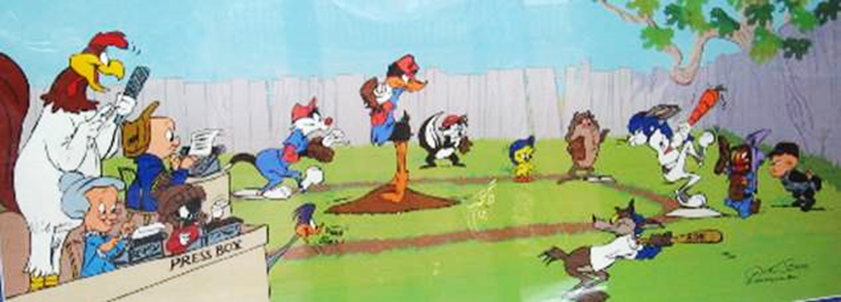
Looney Tunes – Baseball Cards: In 1991, Upper Deck issued a set of baseball cards featuring Looney Tunes characters with original drawings and stories by Chuck Jones.
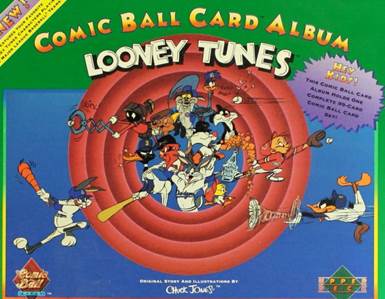
Looney Tunes – Telluride Film Festival: Rita and I have our own connection to Chuck Jones. We have been attending the Telluride Film Festival since 2011. We buy the ACME pass which admits us to the Chuck Jones Cinema where we see most of our movies at the four-day festival.
Why is it called the ACME pass? One of Jones’ creations is the duo of Wile E. Coyote and the Road Runner. The conniving coyote repeatedly attempts to catch the Road Runner with absurd Rube Goldberg contraptions that he receives by mail order from the ACME Corporation.
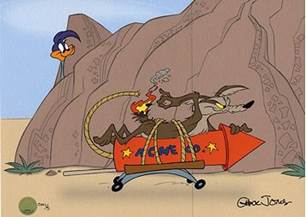
Chuck Jones was a major supporter of the Telluride Film Festival until he died in 2002. Below, our friends Larry and Diana Brewer with us in front of the Chuck Jones Cinema. Note the Bugs Bunny rabbit ears above the theater marquee.

Looney Tunes – George Brett: Do you know why George Brett is known as “Lou” to family, friends and teammates? George explains, “I loved to watch cartoons when I was a kid, and my oldest brother, J.B., started calling me Looney Tunes, which was shortened to Looney, which my mother still calls me, and then to Lou.” This explains why Brett sometimes adds “Lou” to memorabilia and why “LOU” is seen on Brett’s bats.


Looney Tunes – Fernando Tatis Jr.: The All-Star shortstop for the San Diego Padres recently made a catch that went viral (click here). Pundits were calling it a double-jump move because Tatis seems to jump, finds it’s not enough, and somehow gets a boost to go higher. On the “Poscast,” the podcast of Joe Posnanski and Michael Schur, the two hosts likened the Tatis catch to actions taken by Looney Tunes characters who often levitate and suddenly change direction. Think Road Runner and Wile E. Coyote.
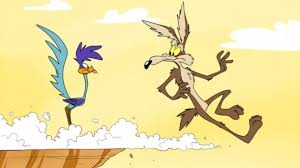
In the final scene of Baseball Bugs, the hero also made an unbelievable catch of a screaming line drive. Click here for the replay.
Looney Tunes – St. Louis Cardinals: Especially for Martin Frost and the many other Hot Stove Cardinals fans – Bugs Bunny, Tasmanian Devil (“Taz”), Daffy Duck and a Stan Musial autograph on home plate.

The Cleveland Guardians: In 2022, the Cleveland Indians will become the Cleveland Guardians. The use of “Indians” has long been controversial, particularly the “Chief Wahoo” caricature used as a logo. To announce the new name, actor Tom Hanks narrated a 3-minute video (click here).

The name has a local connection to the art-deco “Guardians of Traffic,” the eight 43-feet tall sculptures that anchor the Hope Memorial Bridge that leads to Progressive Field. The statues symbolize progress in transportation with each one holding a different vehicle (stage coach, car, truck, etc.).

Cleveland Indians – Bob Hope: The Hope Memorial Bridge was known as the Lorain-Carnegie Bridge when it opened in 1932. It was renamed for “Hope” in 1983. But there is some confusion about who is being honored – Harry Hope, a local stonemason who helped build the Guardian sculptures, or his son, famous Cleveland native Bob Hope. Or maybe both.
Bob Hope was a life-long fan of the Cleveland Indians. When Bill Veeck bought the team in 1946, he recruited Hope as a minority investor. Hope said, “I have a sentimental interest in the club, having been raised in Cleveland, and I have a world of faith in Bill Veeck.” He also said he was following the lead of his frequent co-star Bing Crosby who owned an interest in the Pittsburgh Pirates. They both did promotional work for their teams, and there is a fun movie newsreel of them playing catch and talking baseball during spring training in 1947 (click here).
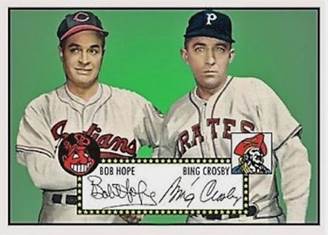
When Veeck sold the team in 1949, Hope also sold his interest. But Hope bought it back in the next year, and in June of 1963 was the cover story in Sports Illustrated (“Bob Hope: A Nut About Sports”). Hope held his interest in the Indians for some 40 years. His pal Bing Crosby kept his interest in the Pirates until his death in 1977.

In October of 1993, Cleveland played its final game in the 74,000-seat Municipal Stadium. Bob Hope was on hand and took the mound to sing a customized version of his signature song “Thanks for the Memories” – he references Bob Feller and Al Rosen and sings that the fans will cheer the Indians no matter where they play (click here). The next season, the team moved to Jacobs Field (now known as Progressive Field).
[Cleveland Owner Trivia: A more recent investor in the Indians was John Sherman of Kansas City. John held a minority interest in the Indians from 2016 to 2019, but gave that up when he became the major owner of the Royals in November of 2019. Below, John at Progressive Field in his Cleveland days, talking to Indians manager Tito Francona.]
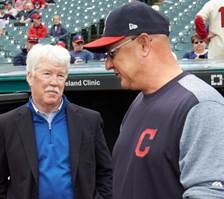
Cleveland Indians – Early Wynn: In Hot Stove #166, I wrote about a 1952 exhibition game that I attended at Municipal Stadium in Kansas City. The game was between the Indians and Giants, and one of pitchers that day was Early Wynn of the Indians. I was ten years old.
That info caught the eye of Clay Coburn who had also seen Wynn at Municipal Stadium. Clay was only nine years old when he saw Wynn pitch against the Kansas City A’s in 1963. Clay remembers the game because Wynn won his 300th game that day (July 13, 1963). Below, Wynn in the KC visitors’ clubhouse after his big victory.
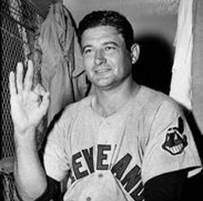
Wynn did not win another game in 1963, and he retired at the end of the season, finishing with a career record of 300-244. He was inducted into the Hall of Fame in 1972.
Llama Update: As you may recall, Rita is a llama maven. This goes back to this 2004 photo from Peru, but her interest was mostly dormant until she got a 2020 calendar with llamas. She then bought a tee shirt with a llama in an “Easy Pose” to complement her daily yoga routine. The inscription on the shirt is “Llamaste,” a play on Namaste. Then napkins. And then other things. The most recent – two throw pillows with a llama in an “Easy Pose.”

But our good friend Talis Bergmanis has eclipsed Rita’s llama love. Talis and his daughter and granddaughters recently participated in a hiking trip in Wyoming, and each hiker was assigned a llama to carry supplies for overnight camping. Below, Talis and his llama (“Thor”). Rita is jealous, but not enough to overcome her lack of interest in camping. Instead, she has her eye on going to “ShangriLlama Castle” in Royse City, Texas. The website is a hoot (click here).

Nature Pics: On my walk last Sunday, I was fortunate to get close-ups of two small animals that usually move too fast for me to get out my phone. Maybe I should get a gimbal and take a video.


Lonnie’s Jukebox – Garth Brooks Master Class: Garth Brooks will be appearing before a sold-out crowd at Arrowhead on Saturday night. Although I’m not a big follower of country music, and I have not seen Brooks in concert, I’m well aware he is a phenomenal entertainer.

At the urging of Bill Carr, Rita and I watched the PBS special on Brooks receiving the Gershwin Prize. The video is available online for PBS members and well worth the time. Teaser here.
I especially enjoyed the segment where Brooks paid homage to the artists who influenced him, in each case playing a brief cover of their songs. He broke down the songwriting process into five parts – painting the picture, story-telling, conversation of the common man, “oomph” and muscle. Here are some of the songs (the original versions) that were part of this master class on songwriting.
“Vincent” (1972) by Don McLean. Painting the picture, with Van Gogh no less.
“Operator (That’s Not the Way It Feels)” (1972) by Jim Croce. One of my favorite storytellers. “She’s living in L.A. with my best old ex-friend Ray…”
“(Sittin’ On) The Dock of the Bay” (1967) by Otis Redding.
“Wild World” (1970) by the artist formerly known as Cat Stevens (Yusaf Islam). Brooks was eight years old when his big brothers brought home Stevens’ Tea for the Tillerman album. “Wild World” and several other cuts from the album were part of the soundtrack for the cult movie Harold and Maude. Rita and I are members of that cult. The video with this link has scenes from the movie.
![Tea For The Tillerman [LP]](https://lonniesjukebox.com/wp-content/uploads/2021/08/tea-for-the-tillerman-lp.jpeg)
“Night Moves” (1976) by Bob Seger. Garth loved this as a teenager.
“Piano Man” (1973) by Billy Joel. “Makin’ love to his tonic and gin…La-la-la de-de da…”
“American Pie” (1971) by Don McLean. “Drove my Chevy to the levee, but the levee was dry…”
During “Piano Man” and “American Pie,” Garth encouraged the audience to sing along. As the TV cameras panned around the venue, you could see it was working. Watching on TV, we were doing the same thing. Brooks was drawing all of us in to make his final point.

The lessons from those who had influenced him had led him to his goal: To write songs so moving that they inspire people to embrace the words and sing along. Songs with universal appeal. He of course has succeeded in reaching that goal, most famously with…
“Friends in Low Places” (1990) by Garth Brooks. This link includes lyrics, to assure getting all the words right.
“Friends in Low Places” by Garth Brooks in concert. He hardly needs to sing. The audience does it for him.
Thanks for the tutorial Garth.
